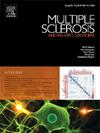多发性硬化症的血管周围间隙:神经炎症的标志还是血管病理的足迹?
IF 2.9
3区 医学
Q2 CLINICAL NEUROLOGY
引用次数: 0
摘要
血管周围间隙(PVS)是围绕穿透性脑血管的间质性充满液体的结构,在脑废物清除、免疫监视和血管健康中起关键作用。当ePVS增大时,在磁共振成像(MRI)上可以检测到,并且与多种神经系统疾病有关,包括多发性硬化症(MS)。多发性硬化症患者的PVS和ePVS数量、大小和体积均高于健康对照(HC),通常出现在半谷中心区和中脑等脑区。年龄和男性通常与更大的ePVS负担相关,血管危险因素,尤其是高血压,是一致的影响因素。尽管如此,ePVS与临床结果(如残疾和认知障碍)以及结构损伤的MRI测量(如局灶性t2高强度白质病变体积和脑容量测量)之间的关联仍然不一致。组织病理学研究正在挑战PVS和ePVS是炎症驱动的传统观点;相反,MS中大多数mri可见的ePVS似乎跟随小动脉,并表现出小血管疾病的特征,包括小动脉壁增厚、含铁血黄素渗漏和细胞外基质重塑。这些异常在很大程度上与脱髓鞘或免疫浸润无关,表明ePVS反映的是微血管病变过程,而不是原发性炎症活动。因此,MS患者的PVS和ePVS可作为血管病变和淋巴功能障碍的影像学标志物。然而,需要标准化的成像方案和纵向研究来阐明其在多发性硬化症中的诊断效用和机制相关性。本文章由计算机程序翻译,如有差异,请以英文原文为准。
Perivascular spaces in multiple sclerosis: Markers of neuroinflammation or footprints of vascular pathology?
Perivascular spaces (PVS) are interstitial fluid-filled structures that surround penetrating cerebral vessels and play critical roles in brain waste clearance, immune surveillance, and vascular health. When enlarged (ePVS), they are detectable on magnetic resonance imaging (MRI) and have been implicated in various neurological diseases, including multiple sclerosis (MS). Patients with MS consistently show higher PVS and ePVS number, size, and volume than healthy controls (HC), often in brain regions such as the centrum semiovale and midbrain. Age and male sex are frequently associated with greater ePVS burden, and vascular risk factors—especially hypertension—emerge as consistent contributors. Despite this, associations between ePVS and clinical outcomes like disability and cognitive impairment as well as MRI measures of structural damage such as focal T2-hyperintense white matter lesion volume and brain volumetric measures, remain inconsistent. Histopathological studies are challenging the traditional view of PVS and ePVS as inflammation-driven; instead, most MRI-visible ePVS in MS appear to follow arterioles and exhibit features of small vessel disease, including arteriolar wall thickening, hemosiderin leakage, and extracellular matrix remodeling. These abnormalities are largely independent of demyelination or immune infiltration, suggesting ePVS reflect microangiopathic processes rather than primary inflammatory activity. Accordingly, PVS and ePVS in MS may serve as imaging markers of comorbid vascular pathology and glymphatic dysfunction. However, standardized imaging protocols and longitudinal studies are needed to clarify their diagnostic utility and mechanistic relevance in MS.
求助全文
通过发布文献求助,成功后即可免费获取论文全文。
去求助
来源期刊

Multiple sclerosis and related disorders
CLINICAL NEUROLOGY-
CiteScore
5.80
自引率
20.00%
发文量
814
审稿时长
66 days
期刊介绍:
Multiple Sclerosis is an area of ever expanding research and escalating publications. Multiple Sclerosis and Related Disorders is a wide ranging international journal supported by key researchers from all neuroscience domains that focus on MS and associated disease of the central nervous system. The primary aim of this new journal is the rapid publication of high quality original research in the field. Important secondary aims will be timely updates and editorials on important scientific and clinical care advances, controversies in the field, and invited opinion articles from current thought leaders on topical issues. One section of the journal will focus on teaching, written to enhance the practice of community and academic neurologists involved in the care of MS patients. Summaries of key articles written for a lay audience will be provided as an on-line resource.
A team of four chief editors is supported by leading section editors who will commission and appraise original and review articles concerning: clinical neurology, neuroimaging, neuropathology, neuroepidemiology, therapeutics, genetics / transcriptomics, experimental models, neuroimmunology, biomarkers, neuropsychology, neurorehabilitation, measurement scales, teaching, neuroethics and lay communication.
 求助内容:
求助内容: 应助结果提醒方式:
应助结果提醒方式:


